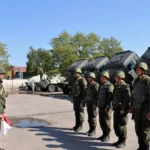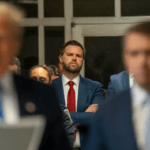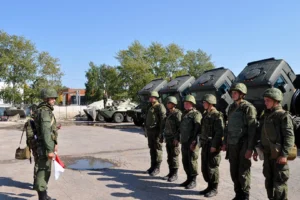
Actors Ryan Reynolds and Rob McElhenney made waves when they purchased Welsh club Wrexham AFC for a reported $2 million. But the two actors are far from the first celebrities to make the leap from show business to the owner’s box. In the United States alone, the history of soccer is littered with big names who’ve dipped their toes into football ownership.
The North American Soccer League, in particular, was rife with big name owners and players. eBay, of course, is full of the remnants of the league, which folded in 1984. Let’s take a look at a few bits of American soccer ephemera that are tied to the league’s celebrity owners.
Undated original photo musician Elton John & soccer great George Best 8×10
Price: $9.99

The Rocket Man is more commonly associated with Watford FC, the English side he supported as a youngster and eventually purchased. But that wasn’t John’s first foray into ownership of a football club. A year before he took ownership at The Vic, John made a splash by investing in the Los Angeles Aztecs of the NASL.
The Aztecs entered the NASL in 1974 and very quickly left their mark, winning the NASL Championship in their very first season. They struggled, though, to captivate local fans while playing at the LA Coliseum, sometimes drawing only a few thousand people to the cavernous venue, which seats over 100,000. In 1975, the club was purchased by local businessman John Chaffetz — father of former Utah congressman Jason Chaffetz — who set about reforming the Aztecs. He hired 25-year-old Terry Fisher, fresh out of college, as the team’s head coach and did his best to attract new investors.
John, meanwhile, had long wanted to own a stake in a football club. Like so many others, he was seduced by the promise of the NASL, an upstart league in a nascent soccer nation that, at that moment, was under the spell of Pele and the New York Cosmos. Not long after Elton John played a now legendary three-hour set at a sold-out Dodgers Stadium, he purchased 50% of the Aztecs for a paltry $350,000.
Well, that’s what was reported. In reality, it was never really clear how much of the Aztecs John owned, if any of it. Some, at the time, said he’d simply licensed the team his name, while others said his ownership stake was more in line with what a modern celebrity owner might enjoy — something along the lines of 1-2%.
Regardless, it was a bit of a coup for the Aztecs. John was stratospherically famous and wasted little time putting that notoriety to good use. He lured Manchester United legend George Best, who by then had become a soccer nomad, to the NASL. The Aztecs applied for, and received, special permission which allowed the Rocket Man to sit on the bench, alongside his players. The league offered a single stipulation: he couldn’t wear an Aztecs uniform. Not that it would’ve mattered: during the couple of games John actually showed up to, it would’ve been tough to get him confused with anyone, as he was usually flanked by a pair of massive bodyguards.
John helped unveil Best to the press in a now famous photoshoot. Pulling out onto the grass at the Coliseum in a silver Cadillac limousine, John emerged wearing a full Aztecs kit and a curious warm-up jacket — a mink coat, to be precise — and a pair of massive, rainbow-colored sunglasses. He cast the coat aside and began ribbing Best about his complexion: “You don’t look well, mate.”
The two posed for photographs, after which John haplessly took part in a passing drill with the assembled Aztecs. The whole thing culminated in a penalty shootout — the normal kind, not the 35-yard variety. Best, predictably enough, emerged victorious, drilling all five attempts into the corners of the goal with aplomb. John converted only one of five, poking it home after instructing the goalkeeper to take note of a plane flying overhead.
John’s visibility with the Aztecs faded after the ‘76 season. Best was a hit for the team but left after a pair of seasons, driven out due to his off-the-field antics. A few years later Chaffetz sold his interest in the Aztecs — along with whatever John’s was, as well — to Mexican broadcaster Televisa. The entire club would fold in 1981.
G’Olé! Soundtrack OST World Cup LP Soccer Prog NM- SynthPrice: $15

Across the country in Philadelphia, the Philadelphia Fury had their own bonafide all-star list of celebrity owners. Peter Frampton, at the time among the biggest rock stars in the world, was joined by YES’ Rick Wakeman and singer-songwriter Paul Simon.
Wakeman, particularly, was intimately involved with the Fury, as was his manager, the incredibly-named Frank Barsalona. The two opened the purse-strings to sign a pair of notable English players: 1966 World Cup champion Alan Ball and ex-English national team striker Peter Osgood. They were joined by Irish star Johnny Giles and bolstered by a far less notable supporting cast — par for the course in the NASL.
The Fury gave birth to an iconic chunk of American soccer design, becoming the first known professional soccer team in the United States to feature a flaming soccer ball in their crest. It’s a motif which would explode in popularity in the ‘80s and become almost ubiquitous in the ‘90s before disappearing almost entirely. The Fury made other notable design choices, as well — hiring a designer to craft their distinctive uniforms, with shorts that were a few inches shorter than normal and jerseys that were made of clingy polyester, a nod to the fact that a large chunk of the NASL’s fans were female.
None of this helped them on the field. Ball, Osgood and Giles all proved to be busts, and the Fury’s manager was sacked in less than 10 games. Ball took over as a player-coach, but he didn’t fare any better. Wakeman, nevertheless, was enamored, often flying to the States between tour dates to watch his club play. As attendance waned, the keyboardist began telling journalists he thought he might have to play a halftime set to attract people to Veterans Stadium.
The Fury finished in last place in 1978 but, because this is American soccer and because everybody makes the playoffs, they still took part in NASL postseason play, where they were bounced out immediately by the Detroit Express. After watching his club average less than 9,000 fans a game, Wakeman abandoned his football fantasy to return to his life as a musician, which has now spanned decades.
Notably, Wakeman wrote and took part in the recording of the scores for a pair of FIFA’s official World Cup films — ”G’Olé!,” which documented the 1982 World Cup in Spain, and “Hero,” the official documentary of the 1986 World Cup, a film widely considered the finest of the lot. Up for grabs here is a vinyl copy of that 1982 soundtrack. We’re fairly sure there won’t be a bidding war over this one.
The Fury pressed on without Wakeman’s money but would fold after the 1980 season. They were sold and moved to Montreal, where they’d become the Montreal Manic.
1981 Washington Diplomats signed team card set
Price: $125

When (or if) you think of the North American Soccer League’s Washington Diplomats — the Dips, for short — you probably think about Johan Cruyff patrolling the midfield at RFK, decked out in the club’s iconic red-and-white kits. Founded in 1974, the Dips had a loyal and steadily growing fan base by 1980, when Cruyff arrived. They averaged nearly 20,000 fans a game that year, a number most modern American clubs would be happy with, yet at year’s end, the club’s corporate overlords (the Madison Garden Corporation) pulled the plug.
But D.C. wasn’t done with the Diplomats. Less than a year later, the Dips were back, resurrected by new ownership for one last shot at glory.
They were owned by British football fixture Jimmy Hill and operated by his son Duncan. Jimmy, who by that time had been a football commentator for years, had done nearly every job there was in the game — player, coach, executive, owner, commentator. At the time, he was also the chairman of English side Coventry City.
Hill’s interest in the NASL started in the mid-’70s, right around the time Pele was starting to convince America in general that soccer might just be worth watching. Flush with cash after a lucrative consulting gig in the Middle East, he decided to roll the dice on a NASL franchise in Detroit, dubbing his team the Express. The club was a hit for a short spell, playing in the then-new Pontiac Silverdome and featuring English phenom Trevor Francis, one of the most prolific goalscorers the league had ever seen. Francis left in 1979 — becoming the first player ever to command a $1 million transfer fee — and Detroit’s fans left with him. The Express drew poorly in their final season, so Hill packed up the team and moved them to Washington.
The Diplomats 2.0 were a far cry from the originals, dubbed by some locals as the “Zombie Dips.” They were led by a core of journeyman Brits, most notably former Diplomat Paul Cannell, a productive center forward who locals called the “Mayor of Georgetown,” a nod to his off-field exploits. Those included, but were not limited to: dating first daughter Susan Ford, nearly getting arrested at Dulles International Airport for smuggling illegal meat into the country, hanging out with John DeLorean (one of many things that earned him the nickname ‘Cocaine Cannell’) and being such a prolific patron of local pub Sign of the Whale that they kept a change of clothes there for him.
Cannell was a shadow of the player he’d been with the Dips of the mid-’70s and was surrounded by an underfunded supporting cast, for the most part. The club slogged through the first half of the season, as attendance dwindled at RFK Stadium. In a desperate attempt to drum up publicity and interest in the team, Jimmy Hill lured Cruyff — who by then was in the midst of a disastrous season at Spanish side Levante — back to the States. The Dutchman played just three games for the reincarnated Dips as he struggled with a groin injury.
“We went up to Montreal for our last game of the season,” remembers Bradford. “It was weird, because Jimmy Hill came with us on the flight. I was talking to Ken Furphy, our coach, and he was like, ‘Jimmy Hill is going straight home to England, he’s not coming back.’ I asked him why, and he said, ‘Because he doesn’t want to get stuck in America.’ Obviously he turned into a runner. I don’t know if he might’ve ran with some money or whatever.”
The Dips did have one last ray of hope — even after losing that game against Montreal, they could still make the playoffs if a few other results fell their way. Many of the Dips found out they’d been eliminated while out partying at a local club. At a payphone, they listened to scores from around the league on the Washington Post’s scoreline. By that point, both of the Hills — father and son — were back in the UK.
“We more or less knew it was all over at that point,” said Bradford. Local efforts to purchase the team for just $2 million — led by long-time NASL coach Gordon Bradley — were fruitless. Days later, the club folded. In an interview with the Post, Duncan Hill said his family had no intention of repaying any of their debts Stateside. It was his understanding, he said, that creditors in the UK were paid off in a liquidation sale when a company goes under.
“I suppose that’s what happens in the States, too,” he said.
The Diplomats name, though, wouldn’t die. It would be reincarnated again in 1987, used by a franchise in the American Soccer League for a few years. More recently, the Diplomats have been reborn in the “National Soccer League,” an organization that still somehow feels entirely imaginary.
Source: The Athletic












